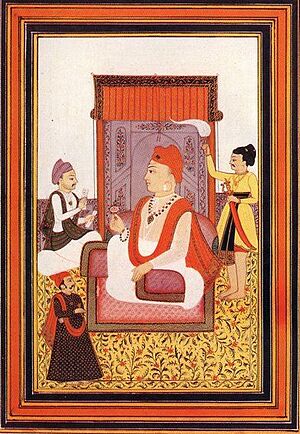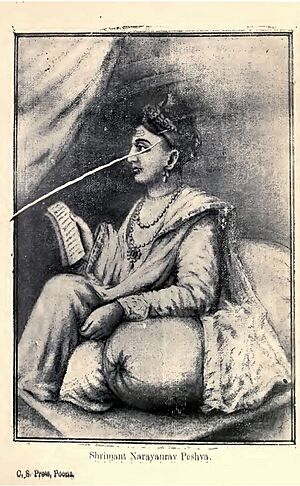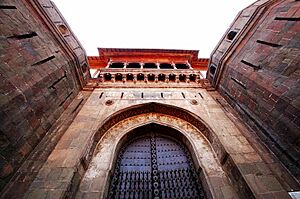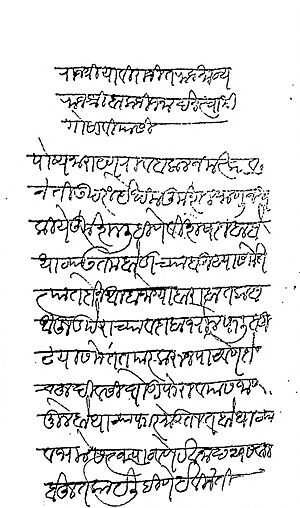Narayan Rao facts for kids
Quick facts for kids
Shrimant Peshwa
Narayan Rao
|
|
|---|---|

Portrait of Narayan Rao
|
|
| In office 13 December 1772 – 30 August 1773 |
|
| Monarch | Rajaram II |
| Preceded by | Madhavrao I |
| Succeeded by | Raghunathrao |
| Personal details | |
| Born | 10 August 1755 Shaniwar Wada, Pune, Maratha Confederacy (modern day Maharashtra, India) |
| Died | 30 August 1773 (aged 18) Shaniwar Wada, Pune, Maratha Confederacy (modern day Maharashtra, India) |
| Cause of death | Assassination |
| Spouse | Gangabai Sathe |
| Children | Sawai Madhavrao |
| Parents |
|
| Relatives |
|
Narayanrao (born August 10, 1755 – died August 30, 1773) was a young leader of the Maratha Empire. He became the 10th Peshwa (like a prime minister) of the Maratha Confederacy in November 1772. Sadly, he was assassinated in August 1773. He was married to Gangabai Sathe, and they later had a son named Sawai Madhavrao.
Contents
Early Life of Narayanrao
Narayanrao Bhat was born on August 10, 1755. He was the youngest of three sons of Balaji Baji Rao, also known as Nana Saheb, and his wife Gopikabai. He learned to read, write, and do math. He also understood some ancient Sanskrit texts.
Narayanrao married Gangabai Sathe on April 18, 1763, when he was not yet eight years old. Gangabai was from Kelashi village. Narayanrao was very close to Parvatibai, his uncle's widow. She cared for him after her husband's death.
His oldest brother, Vishwasrao, who was supposed to become Peshwa, died in the Battle of Panipat in 1761. His father died a few months later. Then, his elder brother Madhavrao became the Peshwa.
Narayanrao went with his brother Madhavrao on trips to the Carnatic region in 1765 and 1769. He was hurt in his wrist during a battle in April 1770. In the last years of his brother's rule, Narayanrao was trained in government work by the minister Sakharam Bapu. However, his brother Madhavrao worried about Narayanrao's future.
Becoming the Peshwa
Before he died, Madhavrao held a special meeting. He chose his younger brother Narayanrao to be the next Peshwa. Madhavrao advised Narayanrao to listen to Sakharam Bapu and Nana Padnavis.
Raghunathrao, who was the uncle of both Madhavrao and Narayanrao, didn't openly disagree. But Madhavrao had ordered that Raghunathrao should remain confined. This was to stop him from causing trouble. Raghunathrao tried to escape just before Madhavrao died, but he was caught.
Madhavrao passed away on November 18, 1772. Narayanrao then went to Satara to officially receive his new title from Rajaram II. This happened on December 13. At the same time, Sakharam Bapu became the "Chief Administrator."
Narayanrao's Rule
Challenges and Disagreements
Narayanrao faced many challenges during his short time as Peshwa.
The Gardi Soldiers
The Peshwas used Gardi soldiers for security around the palace and the city of Pune. There were less than 5,000 Gardis. They came from different parts of India and other countries. They were paid a monthly salary. The Gardis saw their work as purely business.
Narayanrao inherited an empty treasury from his brother. Madhavrao had used up all the money to pay off the empire's debts. Also, the Gardis no longer had a strong leader. They were unpaid and disorganized. This made them a problem for the Marathas. However, Narayanrao and his advisors did not pay enough attention to this issue.
The Prabhu Community
The Prabhus were an important group in the Maratha empire. They believed they belonged to the "warrior" class. This allowed them to perform certain religious ceremonies. In the past, this had been agreed upon.
However, Narayanrao decided to change this. He lowered their social status. He made them sign an agreement to accept this change. This action made the Prabhu community lose trust in Narayanrao. They later supported his uncle, Raghunathrao.
Sakharam Bapu's Disagreements
Sakharam Bapu believed in finding solutions through discussion. Narayanrao, however, was often quick-tempered. Their different approaches soon caused problems.
For example, they disagreed about who should be the governor of Vasai. Sakharam Bapu supported an official named Visajipant Lele. But Visajipant Lele had been removed by Madhavrao for misusing government money. Narayanrao ignored Bapu's advice and chose someone else.
They also disagreed about the Patwardhan Sardars. These leaders had become very powerful. Sakharam Bapu and Raghunathrao wanted to reduce their power. Narayanrao did not like this. Because of these growing differences, they decided to ask Gopikabai, Narayanrao's mother, for advice. They met her in March 1773, but they could not find a solution.
Other Officials
Many officials in Pune had negative opinions of Narayanrao. They described him as impatient and immature. He sometimes disrespected Sakharam Bapu and other older officials.
Nana Phadnavis, another important minister, kept his distance. He only got involved when it was absolutely necessary. This meant he didn't notice the plots happening in the city. Other officials also showed little interest in helping the Peshwa.
Raghunathrao's Confinement
First Escape Attempt
At first, Narayanrao and his uncle Raghunathrao got along well. Narayanrao even helped arrange his uncle's daughter's wedding in February 1773.
But later, when Narayanrao was away, Raghunathrao tried to escape. He started gathering his own soldiers and asked Haidar Ali for help. The officer in charge of law and order in Pune increased security around Raghunathrao.
When Narayanrao heard this, he returned to Pune. He brought Raghunathrao back to the palace on April 11, 1773. He added more guards to stop him from escaping. This made their relationship even worse. In July 1773, Raghunathrao became so angry that he threatened to starve himself and his family. Narayanrao couldn't calm him down.
Second Escape Attempt
Two agents from Nagpur came to Pune. They wanted the Peshwa to approve a new ruler for Nagpur. But when they saw the tension between Narayanrao and Raghunathrao, they saw a chance to benefit. Narayanrao was supporting a different person for the Nagpur throne.
The agents secretly met with Raghunathrao. They planned to capture Narayanrao and make Raghunathrao the Peshwa. In August 1773, Raghunathrao tried to escape at night. He was caught, but his helper got away.
Narayanrao then made his uncle's confinement even stricter. Raghunathrao was not allowed to leave his room. His daily life was restricted. This made him furious. Unlike his elder brother Madhavrao, Narayanrao did not try to keep his uncle's supporters happy. This allowed them to unite against him.
Third Escape Attempt
Raghunathrao also got help from Haidar Ali's ambassador in Pune. When Narayanrao found out about this, he confined his uncle even more strictly. Raghunathrao then declared he would starve himself to death. For eighteen days, he ate almost nothing. Finally, Narayanrao promised him land and money if some important leaders would guarantee his good behavior.
Foreign Relations
In April 1772, the British in Bombay wanted to gain control of certain islands near Mumbai. They also wanted to have a British agent in Pune. Thomas Mostyn, who knew the Pune court, was chosen for this task. He arrived in Pune in October 1772. He watched the events closely and advised the British to try and take these places.
After Madhavrao died and Narayanrao became Peshwa, the British navy saw an opportunity. They began attacking Maratha forts like Thane, Vasai, Vijaydurg, and Ratnagiri. But Narayanrao acted quickly. He sent Trimbak Vinayak with money to stop the British. Trimbak Vinayak and the Maratha naval officer Dhulap successfully fought off the British attacks. However, Mostyn stayed in Pune, waiting for another chance.
Nagpur Succession Dispute
When the ruler of Nagpur, Janoji Bhonsle, died in May 1772, a fight for power began between his sons, Mudhoji and Sabaji. This dispute also caused disagreements in the Pune court. Sakharam Bapu and Raghunathrao supported Mudhoji. Narayanrao and Nana Phadnavis supported Sabaji.
The brothers eventually agreed that Mudhoji's son, Raghuji, would become the ruler of Nagpur. This agreement needed the Peshwa's approval. So, two agents, Vyankatrao Kashi Gupte and his brother Lakshman, were sent to Pune.
These agents belonged to the Prabhu community. They were upset with Narayanrao because he had lowered their social status. The two agents then tried to help Raghunathrao escape. Narayanrao was very angry about their actions. On August 16, 1773, he ordered them to return to Nagpur. He also recognized Sabaji as the rightful ruler of Nagpur.
Assassination
Between August 16 and 30, many secret talks and plots happened among Raghunathrao's supporters. But since this was common, no one in charge paid much attention.
Since Raghunathrao was confined, his personal servant, Tujali Pawar, carried out the plans. Tujali felt that Narayanrao had wronged him. The new plan was to murder Narayanrao, not just capture him. They believed Sakharam Bapu would not interfere.
Aftermath and Justice
Ram Shastri, the Chief Justice of the Maratha empire, started investigating Narayanrao's killing right away. This was despite Raghunathrao's objections. The investigation lasted about six weeks.
Shastri found Raghunathrao to be the main person responsible. About fifty other people were also found guilty. When Shastri faced Raghunathrao, he bravely told him that he was the main culprit. This showed the power of the justice system. However, Raghunathrao later removed Shastri from his position.
The Barbhais Council
While the investigation was happening, Sakharam Bapu made sure that Gangabai, Narayanrao's pregnant widow, was safe. If she had a son, he would be the next heir. Sakharam Bapu gathered a group of twelve Maratha officials and chiefs. They were known as the Barbhais Council, or "Twelve Comrades." This group included Nana Phadnavis and Mahadji Shinde. Their goal was to protect the future heir and the empire.
Raghunathrao's Short Rule
Raghunathrao could not convince important ministers like Sakharam Bapu and Nana Phadnavis to join his government. He had to rely on other ministers. The two Nagpur agents also continued to support him.
Raghunathrao sent one agent to invite Mudhoji Bhonsle to Pune with his forces. He officially received his title as Peshwa on October 10, 1773. He made his own official seal, leaving out the name of Rajaram II.
During a festival, Raghunathrao had to deal with the Gardi chiefs. They held a lot of power and wanted money from him. They even threatened to remove him and put someone else in power if they weren't paid. Raghunathrao had to pay them a large sum of money.
Raghunathrao now had few strong supporters. His financial problems eased when a treasure of 22 lakh rupees arrived in Pune. Raghunathrao quickly took this money.
Narayanrao's Legacy
- The Narayan Peth area in Pune is named after Peshwa Narayanrao.
- There is a local belief that Narayanrao's ghost still roams the ruins of Shaniwar Wada. People say he calls for help, just as he did when he was assassinated.
- An early Indian silent film about his assassination, called Death of Narayanrao Peshwa, was made in 1915.
Images for kids







